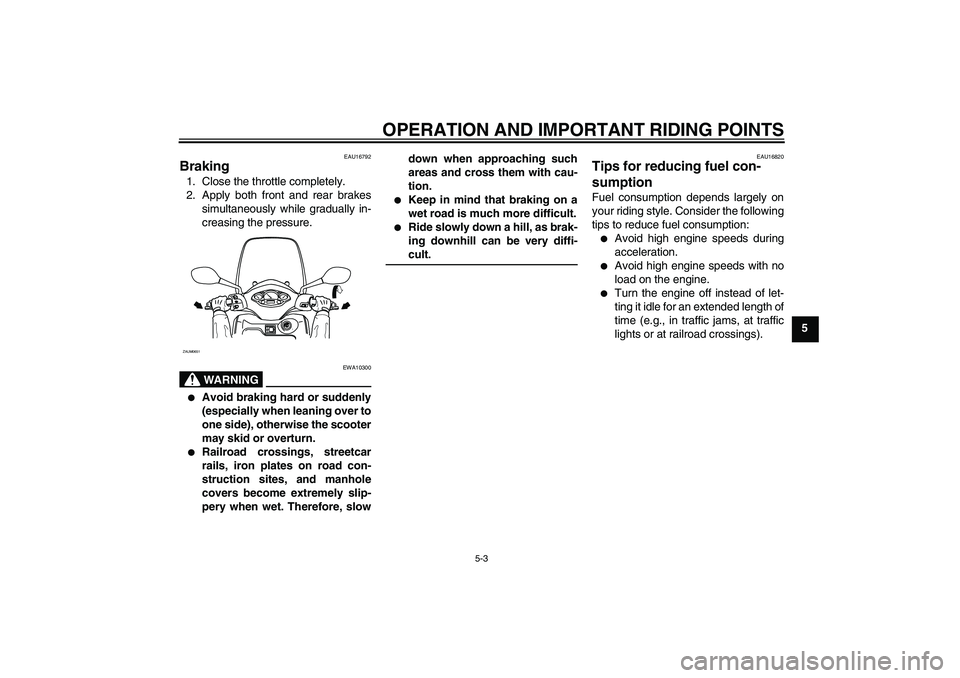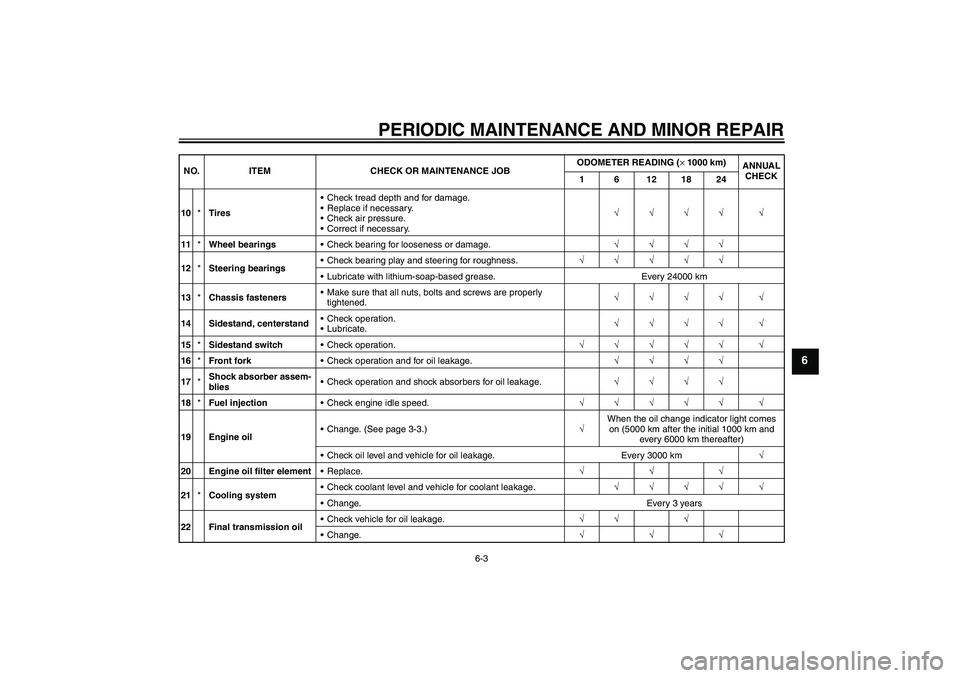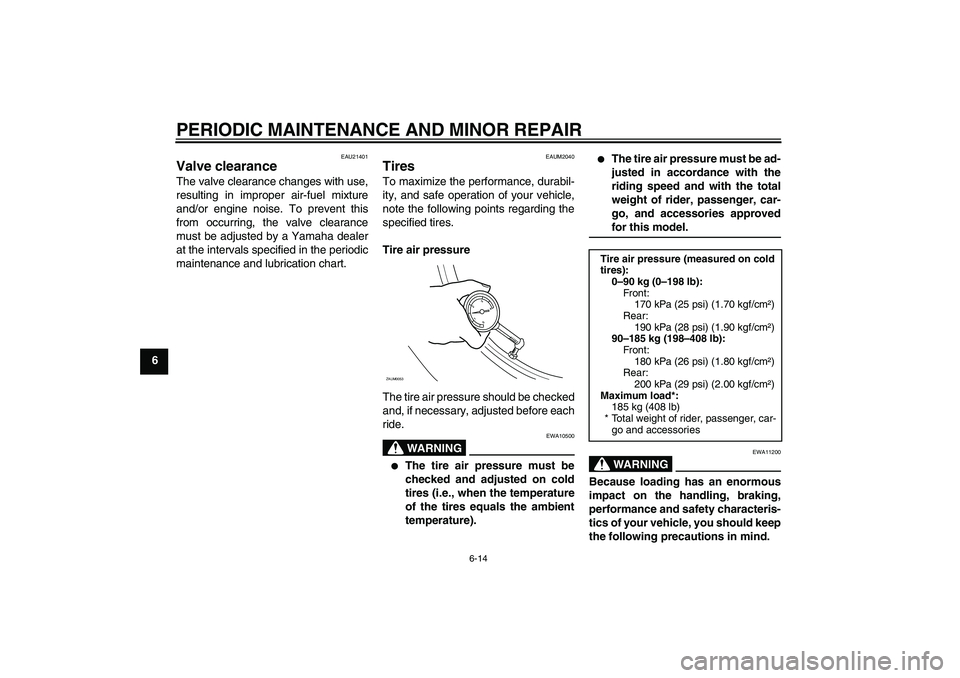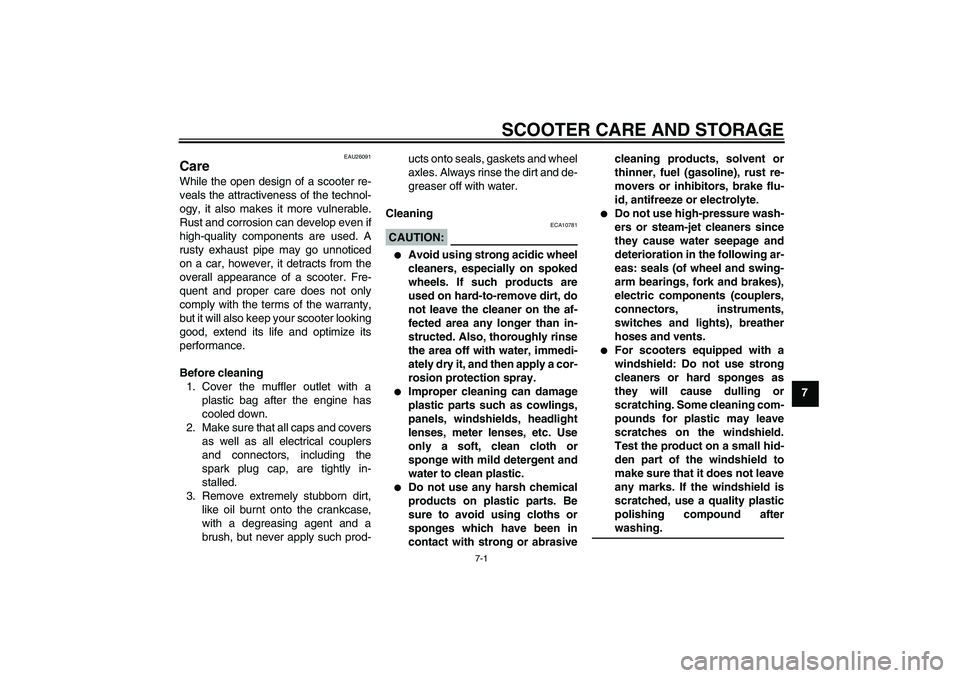Page 37 of 80

OPERATION AND IMPORTANT RIDING POINTS
5-3
5
EAU16792
Braking 1. Close the throttle completely.
2. Apply both front and rear brakes
simultaneously while gradually in-
creasing the pressure.
WARNING
EWA10300
�
Avoid braking hard or suddenly
(especially when leaning over to
one side), otherwise the scooter
may skid or overturn.
�
Railroad crossings, streetcar
rails, iron plates on road con-
struction sites, and manhole
covers become extremely slip-
pery when wet. Therefore, slowdown when approaching such
areas and cross them with cau-
tion.
�
Keep in mind that braking on a
wet road is much more difficult.
�
Ride slowly down a hill, as brak-
ing downhill can be very diffi-cult.
EAU16820
Tips for reducing fuel con-
sumption Fuel consumption depends largely on
your riding style. Consider the following
tips to reduce fuel consumption:�
Avoid high engine speeds during
acceleration.
�
Avoid high engine speeds with no
load on the engine.
�
Turn the engine off instead of let-
ting it idle for an extended length of
time (e.g., in traffic jams, at traffic
lights or at railroad crossings).
PUSHOPEN
ZAUM0651
U16PE0E0.book Page 3 Tuesday, May 8, 2007 10:26 AM
Page 41 of 80

PERIODIC MAINTENANCE AND MINOR REPAIR
6-3
6
10*TiresCheck tread depth and for damage.
Replace if necessary.
Check air pressure.
Correct if necessary.√√√√ √
11*Wheel bearingsCheck bearing for looseness or damage.√√√√
12*Steering bearingsCheck bearing play and steering for roughness.√√√√√
Lubricate with lithium-soap-based grease. Every 24000 km
13*Chassis fastenersMake sure that all nuts, bolts and screws are properly
tightened.√√√√ √
14 Sidestand, centerstandCheck operation.
Lubricate.√√√√ √
15*Sidestand switchCheck operation.√√√√√ √
16*Front forkCheck operation and for oil leakage.√√√√
17*Shock absorber assem-
bliesCheck operation and shock absorbers for oil leakage.√√√√
18*Fuel injectionCheck engine idle speed.√√√√√ √
19 Engine oilChange. (See page 3-3.)√When the oil change indicator light comes
on (5000 km after the initial 1000 km and
every 6000 km thereafter)
Check oil level and vehicle for oil leakage. Every 3000 km√
20 Engine oil filter elementReplace.√√√
21*Cooling systemCheck coolant level and vehicle for coolant leakage.√√√√ √
Change. Every 3 years
22 Final transmission oilCheck vehicle for oil leakage.√√ √
Change.√√√ NO. ITEM CHECK OR MAINTENANCE JOBODOMETER READING (× 1000 km)
ANNUAL
CHECK
1 6 12 18 24
U16PE0E0.book Page 3 Tuesday, May 8, 2007 10:26 AM
Page 52 of 80

PERIODIC MAINTENANCE AND MINOR REPAIR
6-14
6
EAU21401
Valve clearance The valve clearance changes with use,
resulting in improper air-fuel mixture
and/or engine noise. To prevent this
from occurring, the valve clearance
must be adjusted by a Yamaha dealer
at the intervals specified in the periodic
maintenance and lubrication chart.
EAUM2040
Tires To maximize the performance, durabil-
ity, and safe operation of your vehicle,
note the following points regarding the
specified tires.
Tire air pressure
The tire air pressure should be checked
and, if necessary, adjusted before each
ride.
WARNING
EWA10500
�
The tire air pressure must be
checked and adjusted on cold
tires (i.e., when the temperature
of the tires equals the ambient
temperature).
�
The tire air pressure must be ad-
justed in accordance with the
riding speed and with the total
weight of rider, passenger, car-
go, and accessories approvedfor this model.WARNING
EWA11200
Because loading has an enormous
impact on the handling, braking,
performance and safety characteris-
tics of your vehicle, you should keep
the following precautions in mind.
ZAUM0053
Tire air pressure (measured on cold
tires):
0–90 kg (0–198 lb):
Front:
170 kPa (25 psi) (1.70 kgf/cm²)
Rear:
190 kPa (28 psi) (1.90 kgf/cm²)
90–185 kg (198–408 lb):
Front:
180 kPa (26 psi) (1.80 kgf/cm²)
Rear:
200 kPa (29 psi) (2.00 kgf/cm²)
Maximum load*:
185 kg (408 lb)
* Total weight of rider, passenger, car-
go and accessories
U16PE0E0.book Page 14 Tuesday, May 8, 2007 10:26 AM
Page 69 of 80

SCOOTER CARE AND STORAGE
7-1
7
EAU26091
Care While the open design of a scooter re-
veals the attractiveness of the technol-
ogy, it also makes it more vulnerable.
Rust and corrosion can develop even if
high-quality components are used. A
rusty exhaust pipe may go unnoticed
on a car, however, it detracts from the
overall appearance of a scooter. Fre-
quent and proper care does not only
comply with the terms of the warranty,
but it will also keep your scooter looking
good, extend its life and optimize its
performance.
Before cleaning
1. Cover the muffler outlet with a
plastic bag after the engine has
cooled down.
2. Make sure that all caps and covers
as well as all electrical couplers
and connectors, including the
spark plug cap, are tightly in-
stalled.
3. Remove extremely stubborn dirt,
like oil burnt onto the crankcase,
with a degreasing agent and a
brush, but never apply such prod-ucts onto seals, gaskets and wheel
axles. Always rinse the dirt and de-
greaser off with water.
Cleaning
CAUTION:
ECA10781
�
Avoid using strong acidic wheel
cleaners, especially on spoked
wheels. If such products are
used on hard-to-remove dirt, do
not leave the cleaner on the af-
fected area any longer than in-
structed. Also, thoroughly rinse
the area off with water, immedi-
ately dry it, and then apply a cor-
rosion protection spray.
�
Improper cleaning can damage
plastic parts such as cowlings,
panels, windshields, headlight
lenses, meter lenses, etc. Use
only a soft, clean cloth or
sponge with mild detergent and
water to clean plastic.
�
Do not use any harsh chemical
products on plastic parts. Be
sure to avoid using cloths or
sponges which have been in
contact with strong or abrasivecleaning products, solvent or
thinner, fuel (gasoline), rust re-
movers or inhibitors, brake flu-
id, antifreeze or electrolyte.
�
Do not use high-pressure wash-
ers or steam-jet cleaners since
they cause water seepage and
deterioration in the following ar-
eas: seals (of wheel and swing-
arm bearings, fork and brakes),
electric components (couplers,
connectors, instruments,
switches and lights), breather
hoses and vents.
�
For scooters equipped with a
windshield: Do not use strong
cleaners or hard sponges as
they will cause dulling or
scratching. Some cleaning com-
pounds for plastic may leave
scratches on the windshield.
Test the product on a small hid-
den part of the windshield to
make sure that it does not leave
any marks. If the windshield is
scratched, use a quality plastic
polishing compound afterwashing.
U16PE0E0.book Page 1 Tuesday, May 8, 2007 10:26 AM